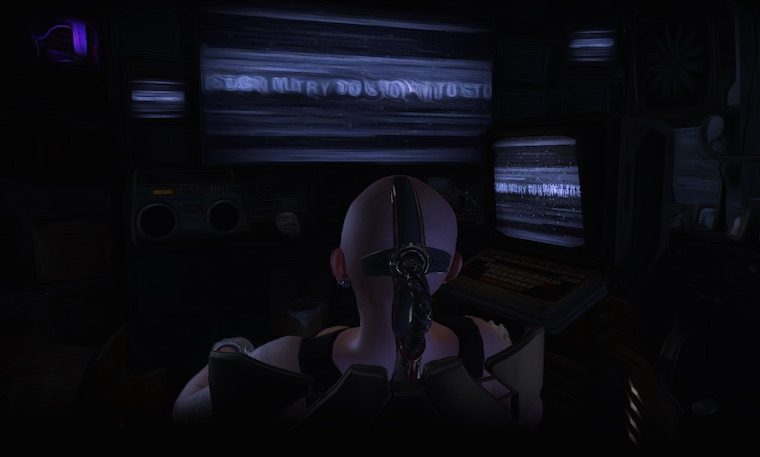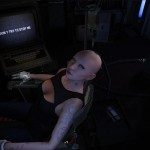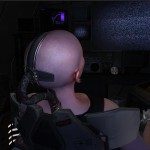Iris VR‘s Technolust is a regular favourite at Road to VR towers, so when its developer Blair Renaud (aka AntiCleric) released a new demo featuring both 3D positional audio and utilising cutting-edge photogrammetry techniques, we had to get our hands on it.
Technolust is probably considered part of VR’s ‘old guard’ these days. Having been released during the DK1 era, its Kickstarter successfully doubled its $30k goal back in May this year and has been updated since with a DK2 compatible version. It’s a cyberpunk thriller set in a dystopian future, with production design heavily influenced by the likes of Blade Runner. It’s always been one of the more intriguing made-for-VR games with a setting and theme well suited to virtual reality.
Recently, Iris VR released a new demo for Kickstarter backers subtitled “A Way Out”. The demo is set entirely within one room, physically speaking at least. You’re dropped into a small apartment packed with static-filled TVs, a blaring ghetto blaster and a mysterious woman seemingly utterly lost in some sort of virtual reality. The TVs read “I Found a Way Out”, somewhat ominously – indicating you, along with the woman are ensnared in a virtual prison of someone else’s making.
The demo itself doesn’t offer up a huge amount in the way of gameplay, but to decry it for this this is to miss the point entirely. Technolust is a good example of a genre enabled by VR. The apartment is packed with items to discover and collect, with incidental detail the core of Technolust‘s charm. Simply being in and interacting with the world of Technolust is enough, a statement that usually could not be levelled at standard, monitor based gaming.
The narrative is progressed by picking up and interacting with objects within the room. A description which hardly sounds thrilling, but thanks to the wonderful attention to detail, superb production design and lighting, some rather neat twists and the power of VR and it becomes completely absorbing. And, thanks to some technical enhancements implemented in this release, it’s also extremely immersive.
Oculus announced at their inaugural ‘Connect’ conference in September that audio in VR was extremely important to them. The Crescent Bay feature prototype announced at the show included integrated headphones and Oculus chose the Realspace 3D positional audio engine to form part of their recommended audio pipeline. Realspace 3D is one amongst a number of 3D audio engines entering the spotlight since the resurgence of VR. A Way Out integrates Realspace 3D audio, and the effect can be quite startling.
See Also: A Preview of Oculus’ Newly Licensed Audio Tech Reveals Stunning 3D Sound (download)
Firing up the demo, as I enter the room, I’m surrounded by a cacophony of noises, the loudest being the enormous 80s style ghetto blaster blaring electronica. As I turn to face the blaster, the music pans convincingly from behind my right ear to rest just in front of me. It’s an eery effect, and as I described in my Realspace preview (linked above), it can conjure moments of presence purely on the basis of the soundstage it can construct. Turning the blaster off reveals a selection of incidental and environmental hums and whirs, and a quiet, robotic voice informing me I have a text message. Again, swinging around to find the source of the sound sweeps the soundstage around to match, these noises are realistically anchored in this virtual world. I can’t overstate how powerful and important the use of positional audio is. It’s not just an accompaniment, it’s another key actor in the scene unfolding before you.
As well as supercharged sound, A Way Out sports a central character who’s modeled with the assistance of a group of techniques colloquially known as ‘photogrammetry’. The term refers to the capturing of a series of digital images and 3D geometry to produce a 3D digital asset that can be used in a virtual world. The company behind the photogrammetry is Quantum Capture, based in Toronto, Canada. 3D assets produced by them are not only extraordinarily realistic, they are full animatable too. For this reason, when you first remove the DK2 from the mysterious women occupying the apartment, you’re met with two, startlingly human eyes. Thanks to VR, that moment is unnerving at best. It’s astonishing to think where the meshing of VR and photo-realistic models such as these will lead us.
Whilst the mood of the demo is sinister, brooding and sombre – the game does take a delightful turn for the bizarre when it launches you into a fully realised version of Look and Loot: Epic Pets, another of Iris VR’s titles – albeit on Samsung’s Gear VR headset. It’s a wonderfully juxtaposed mash-up that inevitably doesn’t last long, but it makes your re-insertion into that oppressive apartment space all the more effective.
It’s all very intriguing and I could speculate as to meaning, subtext and where this fits into Technolust’s eventually fully realised narrative, but I won’t. Blair Renaud is keen to point out that this is a tech-demo right now, albeit you will encounter this part of the story when Technolust proper arrives. As we’re keen on saying at Road to VR, we’re very much looking forward to seeing more!
You can find more on Technolust at the pre-order page here, follow the lead developer Blair Renaud on Twitter and (featured in this demo) Look and Loot can be ordered now for Gear VR.












